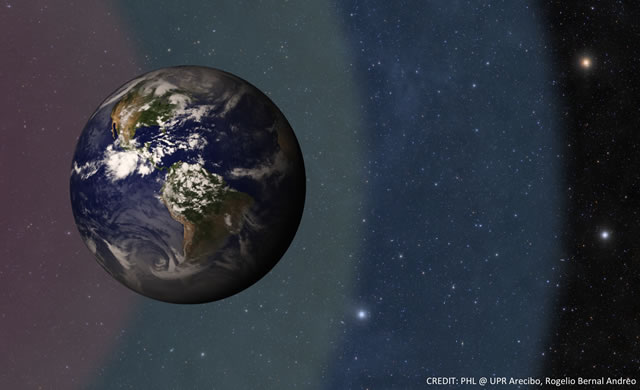
Un team di astronomi della Penn State guidata da Ravi Kumar Kopparapu e Ramses Ramírez, collaboratori anche del PHL, ha annunciato una ridefinizione del concetto stellare di “zona abitabile”.
Il loro studio ha implicazioni forti su come possiamo cercare e studiare esopianeti potenzialmente abitabili. La conclusione principale del loro studio è che le zone abitabili sono in realtà più lontane dalle stelle di quanto si pensasse. È interessante notare che la Terra sembra essere ora situata al margine interno della cosiddetta “zona abitabile”.
Il nuovo studio si basa sul precedente lavoro di James Kasting, professore Evan Pugh di Geoscienze presso la Penn State, che anche uno dei co-autori. Attualmente, tutte le definizioni realtive alla zona abitabile si basano sul lavoro pionieristico del dottor Kasting. Le stime effettuate con la nuova definizione di zona abitabile suggeriscono che alcuni pianeti extrasolari precedentemente creduti nella zona abitabile potrebbero invece non esserlo. Tuttavia lo studio non ha ancora preso in considerazione le valutazioni complicati delle nubi che aiutano anche a stabilizzare climi. Il Catalogo Exoplanet abitabile del PHL di (HEC) sarà certamente influenzato dalla nuova definizione della zona abitabile. Questo porterà variazioni rispetto alla classificazione di un certo numero di pianeti extrasolari potenzialmente abitabili, su quei quasi 900 confermati e gli oltre 2.700 esopianeti candidati da Kepler della NASA.
Di recente, l’indice di somiglianza della Terra (ESI), una misura comparativa con il nostro Pianeta e altre metriche di abitabilità, sono state aggiornate dal PHL. La ESI non si basa sulla definizione della zona abitabile ma attraverso altre considerazioni che sono state usate per migliorarla. Un maggiore rilascio di informazioni di HEC, che riflette tutti questi risultati, sarà presentato attraverso una conferenza pubblica presso l’Osservatorio di Arecibo, Sabato 16 Febbraio 2013 @ 06:00 AST (05:00 EST) e disponibile presso la sede del PHL Lunedi 18 febbraio 2013 @ 09:00 AST (08:00 EST).
A team of astronomers from Penn State led by Ravi Kumar Kopparapu and Ramses Ramírez, also PHL collaborators, announced a redefinition of the classical stellar habitable zone.
Their study has strong implications on how we search and study potentially habitable exoplanets. The main conclusion of their study is that the habitable zones are actually farther away from the stars than previously thought. Interestingly, Earth appears to be now situated at the very inner edge of the habitable zone.
The new study builds on the previous work of James Kasting, Evan Pugh Professor of Geosciences at Penn State, also one of the co-authors. Currently, all definitions of the habitable zone were based on Dr. Kasting’s pioneering work. Estimates with the new habitable zone suggest that some exoplanets previously believed to be in the habitable zone may not be. However, the study has not as yet taken into account the complicated feedback of clouds, which also help to stabilize climates. The PHL’s Habitable Exoplanet Catalog (HEC) will certainly be impacted by the new definition of the habitable zone. This will affect the classification of a number of potentially habitable exoplanets out of those nearly 900 confirmed and the over 2,700 NASA Kepler exoplanets candidates.
Recently, the Earth Similarity Index (ESI), a measure of Earth-likeness, and other habitability metrics were updated at the PHL. The ESI does not rely on the definition of the habitable zone but other considerations were used to improve it. A major release of HEC, reflecting all these results, will be presented via a public lecture at the Arecibo Observatory on Saturday, February 16, 2013 @ 6 PM AST (5 PM EST) and available at the PHL’s site on Monday, February 18, 2013 @ 9 AM AST (8 AM EST).
Source/Continue reading → Planetary Habitability Laboratory (PHL)





















